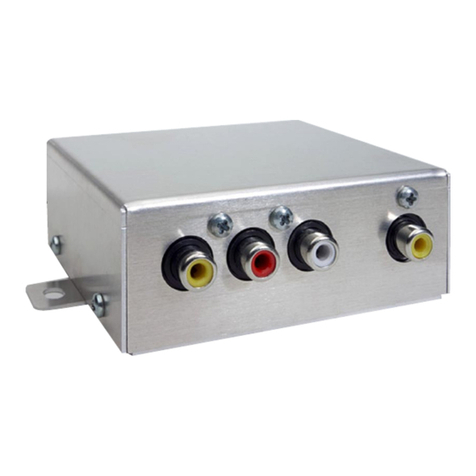TouchTronics PowerTouch 814 Series User manual

NST13308-P814_A 2020-06-10 Page 1
57315 Nagy Dr
Elkhart, IN 46517
800-294-2570
574-294-2570
www.touchtronics.com
By TouchT
ronics, Inc.
PowerTouch Remote Control Systems - 814 Series (2 - 4) Functions
Compact
Receiver is small and easy to install.
Flexibility
Installer can select polarity of voltage outputs on two different channels.
Optional T ransmitters
Large, oval transmitters with large buttons can be ordered.
Extra Channels
Two extra channels are available at no extra cost.
Special Featur es and Applications
814 PowerTouch Remote Control Receiver
With Two Key Chain Transmitters and
Shown With Optional Oval Transmitter
co mi lE no ca
nda
C mpao ct
Please r ead entire instruction manual prior to starting the
PowerT ouch Remote Control System Installation.
PowerTouch 814
Range
Typical antenna range is 60-feet.
Optional
Oval
Transmitter

NST13308-P814_A 2020-06-10 Page 2
Contents
Special Features and Applications Page 1
Contents, Specications, Installation Tools, Technical Support Page 2
Component Parts List Page 3
Operation: Remote Control Page 3
Installation: Planning Page 4
Installation: Receiver Power & Ground Page 4
Installation: Electrical Page 5
Installation: Application Schematics Page 6
Installation: Motors Using Relays, Safety Disable Switch Page 7
Trouble Shooting Guide Page 8, 9, 10
Limited One (1) Year Warranty Page 11
Blank Page (Installation Notes or Diagrams) Page 12
Specications
814 Receiver: FCC Approved
RF System 6561 Digital Codes
Voltage 12 Volt DC (available in 24 Volt DC)
Output 300mA
Frequency 300 MHz
Range 60 Feet (typical - using standard 36” grey, wire style, antenna)
Note: Range may be extended with an externally mounted antenna
814 Transmitter: FCC Approved
RF System 6561 Digital Codes
Battery 12 Volt DC (type 23A)
Cycles 32,400 One Second Pulses
Frequency 300 MHz
Note: Key chain style transmitters are water resistant, NOT water proof
Oval style transmitters are water and dust resistant
Physical:
Receiver: 3” x 1” x 2” (width, height, depth)
Transmitter: 1 ½” x 2” (width, length) key chain style
2” x 4 ½” (width, length) oval (hand held) style
Installation Tools
Voltmeter, analog or digital
Phillips Screw Driver
Adjustable Wrench
Screw Driver
Wire Cutter
Wire Stripper
To Clean Grounding Pad: Scraper, Sand Paper, Alcohol Based Cleaner
Technical Support
Visit the factory website to download a copy of these instructions, e-mail technical questions and see other
TouchTronics, Inc. products.
Phone / Fax Numbers
Indiana Local 1-574-294-2570
Toll Free 1-800-294-2570
Fax 1-574-293-1611
Web Site
www.touchtronics.com
E-Mail
‘Contact Request’link on the web page
PowerTouch Remote Control Systems - 814 Series (2 - 4) Functions

X
NST13308-P814_A 2020-06-10 Page 3
1) 1 pc 814r RF Receiver , 4 Channel
w/36” antenna wire
2) 1 set 814h Harness - 8 wire, 9”
3) 2 pcs 814T3 Transmitter,
3 button key chain style
Optional 814T4XS Transmitter,
4 button oval (hand held) style
Component Parts List
Operation: Remote Control
Transmitters:
1) Press and releasebutton
Or
2) Press and hold button
3) Red Status LED
Signal is sent to receiver - 1 second pulse
Signal is sent to receiver as long as button
is held. Signal will stop when button is
released.
A) LED On red indicates signal is being
sent
B) LED On bright indicates battery
voltage is ok.
Button
A
B
A & B
Pressed @ same time
Back Button
Channel
1
2
3
4
Function
Motor or Lamp
Motor or Lamp
Motor or Lamp
Motor or Lamp
Signal Output
+12v or Ground(-)
+12v or Ground(-)
Ground (-)
Ground (-)
Signal T ype
Momentary
Momentary
Momentary
Momentary
Transmitter Operation Receiver Operation
Output
300mA Max
300mA Max
300mA Max
300mA Max

X
NST13308-P814_A 2020-06-01 Page 4
1) Receiver Output Voltages
A) The receiver has four output voltage (channels) which will operate four separate circuits.The
output voltage is 12 volts direct current (vdc).The maximum drive current for each of the four
output channels is300mA (maximum) . The four outputs can (drive) turn On small bulbs or
relay coils.
B) Check the power requirement for the bulb before connecting to the receiver
. 12vdc at 0.1amp
(maximum) or 1 watt (maximum)
C) Check the power requirement for the relay before connecting to the receiver.
The relay coil
should be rated for the current requirements. The maximum allowable coil current is 300mA.
2) Determine where the receiver and antenna will be located.
Typically the RF receiver is located under the dash or behind a wall panel in the back. If the receiver
is to be mounted outside the cab area then you must protect the receiver
.
The receiver is NOT
waterproof or moisture resistant*.
DO NOT mount the receiver and antenna:
A) Within 6 feet of a motor
B) Near large bundles of wires
C) Near other antennas or RF devices
D) The antenna should not be touching any metal as this grounds the RF (radio
frequency) signal
*TouchTronics offers weather resistant housings for many different types of applications. Call the
factory @ 1-800-294-2570 for information on yourparticular application needs.
Installation: Planning
Installation: Receiver Power & Ground
WARNING!
Use ONLY a volt meter
to check voltage
during installation and testing.
*Using a test light WILL damage the outputs!
(-)
Battery
(+)
#10 x 3/4” Screw
#10 3/16” Star Washer
#10 3/16” Ring Terminal
Vehicle Frame
Scrape paint and clean area before installing ground screw.
A loose chassis ground connection WILL cause intermittent operation!
Chassis Ground
1
2
3
4
5
6
7
8
1
2
3
4
5
6
7
8
Red
Violet
Pink
Green/Black
Yellow/Black
Brown
Blue
Black
(+) Input +12v Battery Power
(+) Output Channel 1 - Button ‘A’
(+) Output Channel 2 - Button ‘B’
(-) Output Channel 1 - Button ‘A’
(-) Output Channel 2 - Button ‘B’
(-) Output Channel 3 - Buttons ‘A’ & ‘B’
(-) Output Channel 4 - Back Button
(-) Input Ground - Connect to Chassis
Ground using External ToothWasher
PowerT ouch Remote Control System
Series 814 RF Receiver
This device complies with FCC rules part 15.
Operation is subject to the following 2 conditions:
1) This device may not cause harmful interference
2) This device must accept any interference received
including that causing undesired operation
36” Gray AntennaWire
*Maximum output current 300mA.
Over current will damage outputs.
Fused 1a Maximum

NST13308-P814_A 2020-06-10 Page 5
Installation: Electrical
1) Install Power
Connect the Red wire to a constant +12v battery power source. Note: For best performance, run a
clean +12v (300mA) directly from the battery or a fuse that is NOTsupplying any power to motors,
lights or any other type of high current device.
2) Install Ground
Connect the Black wire to chassis ground
A) Scrape all paint and grease away from the body frame.
A loose chassis ground connectionWILL cause intermittent operation of receiver
.
B) Clean the area using an alcohol based cleaner to remove paint chips and grease.
C) Crimp a #10, 3/16” ring terminal onto the black ground wire.
D) Insert the ring terminal and a #10, 3/16” star washer over a 10x3/4” hex head,
self-tapping ground screw.
E) Tighten ground screw securely into clean frame area.
3) Install Outputs - Maximum output is 300mA
**Unit will be damaged if more than 300mA is drawn from any one circuit.
A) Connect only One Channel output wire at a time to a relay or function which uses 300mA or
less. (On channels 1 and 2; choose either the negative or the positive wires, NOT both)
B) Solder connections and protect with shrink tube or use an 18g insulated butt terminal.
Channel
Channel 1
Channel 2
Channel 3
Channel 4
Output
(+) positive
OR
(-) negative
(+) positive
OR
(-) negative
(-) negative
(-) negative
W ir e Color
Violet
OR
Green/Black
Pink
OR
Yellow/Black
Brown
Blue
Max Output
300mA
300mA
300mA
300mA
300mA
300mA
Pin Position
2
4
3
5
6
7
WARNING!
If the output wires are installed to the wrong polarity, the output will be damaged. For example: if
the channel 2 pink (+12) output wire is connected to a ground, a ‘dead short’ will occur when the
button is pressed.The output will test ‘dead’and the trace may be burned or test ‘high (On)’
at all
times.
4) W iring Inspection
A) Check all wiring connections visually
B) Check the polarity of all wires
30
87a
85
86
87
Relay 1
1
2
3
4
5
6
7
8
1
2
3
4
5
6
7
8
(-)
Battery
(+)
M
Chassis
Ground
Chassis
Ground Ground
Sample
Installation
With a Relay
See Diagram on Page 4
30
87a
85
86
87
R elay Schematic
Red
Violet
Pink
Green/Black
Yellow/Black
Brown
Blue
Black

NST13308-P814_A 2020-06-10 Page 6
Installation: Suggested Application Schematics
Red
Violet
Pink
Gr/Bk
Yl/Bk
Brown
Blue
Black
1
2
3
4
5
6
7
8
1
2
3
4
5
6
7
8
P we Touch 814o r
ceiverR e
Unlock
Lock
Unlock
Lock
Driver Door
Lock Switch
Pass Door
Lock Switch
Typical Current
Draw is 100mA
R eversal Rest@ G round System
Red
Violet
Pink
Gr/Bk
Yl/Bk
Brown
Blue
Black
1
2
3
4
5
6
7
8
1
2
3
4
5
6
7
8
e To h 8Pow r uc 14
i rR ece ve
Unlock
Lock
Unlock
Lock
Vehicle Door
Lock R elays
To Door
Lo ck M otors
Driver Door
Lock Switch
Pass Door
Lock Switch
Typical Curr ent
Draw is 100mA
per channel
Positive Pulse System
(+)
(+)
Red
Violet
Pink
Gr/Bk
Yl/Bk
Brown
Blue
Black
1
2
3
4
5
6
7
8
1
2
3
4
5
6
7
8
P e To h 8 4ow r uc 1
ei erR ec v
Unlock
Lock
Unlock
Lock
Vehicle Door
Lock R elays
To Door
Lo ck M otors
Driver Door
Lock Switch
Pass Door
Lock Switch
Typical Curr ent
Draw is 100mA
per channel
Negative Pulse System
(-)
(-)
30
87a
85
86
87
30
87a
85
86
87
Driver Door
Lock Relay
Pass Door
Unlock Relay
To Door
Lock Motors
+12v Fused
The following schematics are for reference only. The installer must verify that the circuit is properly wired
with the correct gauge of wire, and properly fused with the correct fuse size and type for the circuit.
Vehicle window switches and door lock switches can be designed as a positive pulse, a negative pulse or
a reversal rest @ ground circuit.
To determine which type is used in your vehicle, take a voltmeter and probe one of the output wires a the
switch. Check the polarity with the switch pressed and without the switch pressed. Compare results with
the chart below.
Window or Door Lock Switch
Positive Pulse
Negative Pulse
Reversal Rest@Ground
Switch NOT Pressed
No Voltage / Floats
No Voltage / Floats
Ground
Switch Pressed
+12 Volts
Ground
+12 Volts
Typical # of Wires
3 Wires
3 Wires
5 Wires
+12v
Lock Unlock
Ground
Lock Unlock
Electrical Diagram
Negative Pulse
Electrical Diagram
Positive Pulse
5
Unlock
Typical Switch
Electrical Diagram
Reversal Rest @ Gr ound
1
Lock
GND
2
+12v
3
GND
4
CUT
(+)
(+) (-)
(-)
(-)
(-)
(+)
(+)
**Please Note:
Due to continually changing wire colors through-out the automotive industry
,
TouchTronics can
NOT provide accurate wire color information on a consistent basis. Therefore, if the wire colors
needed for installation are not known, please contact a local dealer and they should be able to
provide any necessary information.

NST13308-P814_A 2020-06-10 Page 7
Installation: Motors Using Relays, Safety Disable Switch
WARNING! If using any type of motor, such as a window motor, a ramp motor, a door
motor, or a winch motor - add a Disable switch to prevent the door or window circuit from
operating when vehicle is in motion.
A disable switch should be installed in many applications to deny operation of the motor
when a vehicle is in motion. However, due to changes in automotive electrical design and the
addition of computer controlled circuits, it is no longer advisable or safe to tap into or cut wires
to disable automotive factory circuits.To overcome this problem, you must install an electro-
mechanical switch which will determine gear position, thus safely disabling the circuit while the
vehicle is in motion. Below are three options for installing a Safety Disable Switch.
Red
Violet
Pink
Gr/Bk
Yl/Bk
Brown
Blue
Black
1
2
3
4
5
6
7
8
1
2
3
4
5
6
7
8
P we To ch 814o r u
cei erR e v
Unlock
Lock
Unlock
Lock
Driver Door
Lock Switch
Pass Door
Lock Switch
Typical Current
Draw is 100mA
Reversal Rest@ G round System
30
87a
85
86
87
30
87a
85
86
87
Driver Door
Lock Relay
Pass Door
Lock Relay
Door
Lock
Motors
CUT
M M
Red
Violet (+)
Pink (+)
Gr/Bk
Yl/Bk
Brown
Blue
Black
1
2
3
4
5
6
7
8
1
2
3
4
5
6
7
8
P e To h 8ow r uc 14
i rR ece ve
Typical Current
Draw is 100mA
Positive Switch System
30
87a
85
86
87
30
87a
85
86
87
Window Relay
DOWN
Window Relay
UP
+12v Fused
@ 20 am ps
Safety Disable
Switch
M
Window Motor
Down
Window Motor
Up
Ground
High
Current
Ground
+12v Fused
Window
Switch
Down (+)
Window
Switch
Up (+)
Red
Violet
Pink
Gr/Bk (-)
Yl/Bk (-)
Brown
Blue
Black
1
2
3
4
5
6
7
8
1
2
3
4
5
6
7
8
P we To ch 8 4o r u 1
ei erR ec v
Typical Current
Draw is 100mA
Negative Switch System
30
87a
85
86
87
30
87a
85
86
87
Window Relay
DOWN
Window Relay
UP
M
Window Motor
Down
Window Motor
Up
High
Current
Ground
Ground
Window
Switch
Down (-)
Window
Switch
Up (-)
Safety Disable
Switch
Steering
Column
Magn te
1) Attach magnet to gear shifter.
2) Attach switch to dash so that when
magnets are together the switch is NC
and when magnets are apart the
switch is NO
Sw t hi c
Option1: Prox imity Switch
Steering
Column
Option2: Limi t Switch
Limit Swi tch
With Lever
Steering
Column
Option3: Inductive Proximity
Inductive
Proximity
Sensor
ea Shif L everG r t
Gear Shift L ever
Gea Shift L everr
When vehicle is in park, the
safety disable switch is closed
which completes the ground circuit
When vehicle is in park, the
safety disable switch is closed
which completes the power circuit
(-)
Battery
(+)
1a Fuse
Fuse
(-)
Battery
(+)
Fuse
Safety
Disable
Switch 30
87a
85
86
87
Schematic: Automotive Relay

NST13308-P814_A 2020-06-10 Page 8
Use a digital or analog voltmeter to check power and voltage!
Do NOT use a test light
Trouble Shooting Guide - 814 Series Remote Contr
1.0 No output from one
or more channels on
remote control receiver
1.1 No signal from
transmitter
1.2 One or both of the
outputs have failed.
1.3 Receiver outputs ok,
but relays or equipment
do not operate.
1.1 Verify that transmitter is sending a signal and
that transmitter is coded correctly
. See symptom
3.00
1.2a Press each transmitter button in sequence.
While pressing button,
use only a voltmeter probe
to check each corresponding output
(Green/black = button ‘A’)
(Y ellow/black = button ‘B’).
1.2b If checking voltage, a ground signal is
present when button is pressed and oat when not
pressed.
1.2c If checking ohms, the outputs should read 9-
ohms when button is pressed and 0- ohms when
not pressed.
1.2d If outputs read nothing when pressed or not
pressed, then the power supply is damaged.
1.2e Send back to factory for repair or
replacement.
1.2f Any of the above problems can be caused by
a defective unit or damage by the customer from
over-voltage, over-current or testing the inputs
and outputs using a test light instead of a
voltmeter.
1.3 Check wire and equipment for problem
Symptom
Trouble Shooting Guide - 814 Series Remote Control
Possible Cause Corr ective Action
2.0 Signal transmitted
and received, but no
operation.
2.1 No signal from
transmitter
2.2 One or both of the
outputs have failed
2.3 Receiver has failed
outputs
2.1 Check wire harness for loose connections or
damaged wires or terminals
2.2 Check equipment for problem in motors or
relays
2.3 Recheck section 1.0
Symptom Possible Cause Corrective Action

NST13308-P814_A 2020-06-10 Page 9
Trouble Shooting Guide - 814 Series Remote Control
Use a digital or analog voltmeter to check power and voltage!
Do NOT use a test light
3.0 No power to remote
control receiver
3.1 Logic ground or
power connection to
receiver has failed
3.2 Chassis ground
connection has failed
3.1a Check logic ground (black wire) and logic
power (red wire). Use a voltmeter probe when
checking voltage.
3.1b If either ground or power is not present, then
locate failure in wire harness and repair.
3.2a Check chassis ground connection, it should
be clean and tight, no paint on metal, an external
tooth star washer should be present, no rust or dirt
in connection.
3.2b Chassis ground should be located on vehicle
frame.
Symptom Possible Cause Corr ective Action
4.0 No signal (code)
being transmitted
4.1 Battery voltage low
4.2 Transmitter is not
sending a signal
4.3 Transmitter code is
incorrect
4.4 Not all buttons send
a signal when pressed.
4.1 Check battery voltage. Replace battery if
voltage is 11.5 volts or less. (Signal strength is
dependent upon battery voltage.)
4.2 Place probe from voltmeter on battery (+) and
(-) leads. Press any button, voltage should change
by 0.2 to 0.3 volts if a signal is transmitted. Check
both buttons.
4.3a If transmitter is sending a signal and no
signal is being received, re-code transmitter.
4.3b Send back to factory for re-coding.
4.4 If a signal is not transmitted on all buttons,
send back to factory for repair or replacement.
Symptom Possible Cause Corr ective Action
5.0 Poor range 0’to 25’
(pulsating 0’to 25’)
5.1
Antenna damaged or
grounded
5.1a Check antenna placement, it should not be
touching any metal or tinted glass.
5.1b It should not be closer than 6’ to any motors
or relays.
5.1c If it is coiled, then stretch it out and place
near a window.
5.1d If antenna is cut or damaged, send back to
factory for repair.
5.1e NOTE: Antenna can NOT be shortened or
altered in any way
Symptom Possible Cause Corrective Action

NST13308-P814_A 2020-06-10 Page 10
T
rouble Shooting Guide - 814 Series Remote Control
Symptom Possible Cause Corrective Action
5.0 Poor range 0’to 25’
(pulsating 0’to 25’)
5.2 Receiver installed in
poor locations such as
near door or lift motor
5.3 Receiver logic
power input is exposed
to radiated noise from
wire harness or motors
5.4 Receiver logic
ground is exposed to
radiated noise from wire
harness or motors
5.5 Transmitter 12-volt
battery is low
5.6 Out of 25 foot range
5.7 Interference
5.8 Component of
receiver damaged or
defective
5.9 Other equipment
installed in vehicle
causing voltage drop
when initially turning on
5.2a Disconnect door and / or ramp motor and
recheck range.
5.2b If range is ok, then ‘electrical noise’ from
motors is causing interference with RF signal.
5.2c Move receiver and antenna a minimum of 6
feet from the motors.
5.2d If moving receiver 6 feet does not improve,
an external antenna may be required to boost
signal.
5.3a Disconnect receiver logic power input from
main wire harness
5.3b Run new wire from vehicle battery to red
wire.
5.4a Disconnect receiver logic ground input from
main wire harness
5.4b Remove black wire on receiver from wire
harness and install on the vehicle frame for a new
chassis ground or vehicle battery.
5.4c Remove any paint or residue from metal, use
an external tooth star washer and tighten new
chassis ground terminal securely to vehicle frame.
5.5 Replace battery if voltage is 11.5 volts or
below
5.6 Move closer to the vehicle
5.7a Electromagnetic interference (EMI) caused
by any radio frequency (RF) nearby, motors,
welding equipment, relays, etc. May be in close
proximity to receiver / transmitter.
5.7b Move closer to antenna or move vehicle out
of range of EMI caused by radio frequency,
welding equipment, as this is a temporary
problem.
5.7c If EMI is caused by relays, door motors or
lift motors then the receiver must be moved or
shielded or the EMI noise diverted to ground. Call
the factory for details.
5.8 Send back to factory for repair or
replacement.
5.9 Remove all other equipment from logic
ground and power.

NST13308-P814_A 2020-06-10 Page 11
Limited One (1) Year Warranty
Thefollowingrevised warrantyprocedures willbeimplementedand effective March 1, 2002.
1) All products will nowbe shipped withan individual bar codeattached.
2) Thebar code willinclude someor all of thefollowing information.
A) Date of Manufacture
B) Serial Number
C) Privat e Code
D) Part Number
3) Warranty Cards areno longer required to be eligibleto receivetechnicalsupport and service.
4) Ea ch individual product iswarranted under the TouchTronics Limited Warranty programfor
1 fullyear fromdate ofpurchase ora maximum of 2 years from the date of manufacture.
5) No product will becovered under theTouchTronics Limited Warranty program that has a
manufacture date older than2 years.
6) To receive technicalsupport or warrantyservice,simply call our technicalsupportcenter
during regular business hours.
7) To enable our technicalsupport staff to better serve you, please have the following
information available whenyou call.
Manufacture
Purchase
Installation
Date Of:
Dealer Name
Dealer Phone
Make / Model
Vehicle Information:
Part Number
Serial Number
Private Code
Product Information:
Please ll in all pertinent information at
the time of pur chase or installation
TouchTronics, Inc. Warranty Policies and Procedures
SectionOne
Seller will warrant any product originally manufactured or assembled and sold by seller for a period of up to
TWO YEARS (24 months) from the original date of
manufactureor ONEYEAR (12 months) from theoriginal retail saleor O.E.M. in-servicedate.
SectionT wo
The following are in lieu of all warranties; expressed; implied; or statutory, including but not limited to, any implied warranty of merchantability of tness for a particular
purpose and of any other warranty obligation on the part of seller. Seller, except as otherwise hereinafter provided, warranty the goods against faulty workmanship or the
use of defective materials for a period of up toTWO YEARS (24 months) from the original date of manufacture or ONE YEAR (12 months) from the original retail or
O.E.M.in-servicedate.
Sellers sole and exclusive liability shall by (at sellers option) to repair; replace; or credit buyer for such goods which are returned by buyer during the applicable warranty
periodset forth above, providedthat (I) selleris promptlynotied inwriting or phoneupon discoveryby buyerthat suchgoods failed toconform andan explanationof any
alleged deciencies, (II) such goods are returned to seller, (III) sellers examination of such goods shall disclose that such alleged deciencies actually exist and were not
caused by accident, misuse, neglect, alteration, improper installation, unauthorized repair or improper testing. If seller elects to repair or replace such goods, seller shall
haveareasonable time to makesuch repairs orreplace such goods.
Sellers warranties as herein above set forth shall not be enlarged, diminished, or affected by, and no obligation or liability shall arise or grow out of, sellers rendering of
technicaladviceor service.
Damage to products caused by the customer or during installation cannot be claimed under this warranty
. All devices returned that are not covered under the sellers
warranty policy, will be charged a minimum of $25.00 for evaluation plus additional charges for components and labor to repair the device not to exceed the original
selling price. Seller considers the following to be typical examples of customer or installation damage: burned or broken traces on the printed circuit board, burned or
damaged components, dirt or water residue on the printed circuit board or inside the case, modications by the customer, broken cases or housings and dead batteries.
SectionThree
A return material authorization number (RMA) must be issued by seller before any product is returned for evaluation or repair. Warranty repairs must be completed at
authorizedrepair facilities.
Warrantypolicy1 rev a.doc
01.01.03rev a
09.30.98rev int
Eective January 1, 2003
Other manuals for PowerTouch 814 Series
1
Popular Automobile Electronic manuals by other brands

GU Electronic
GU Electronic MASERATI-TD manual
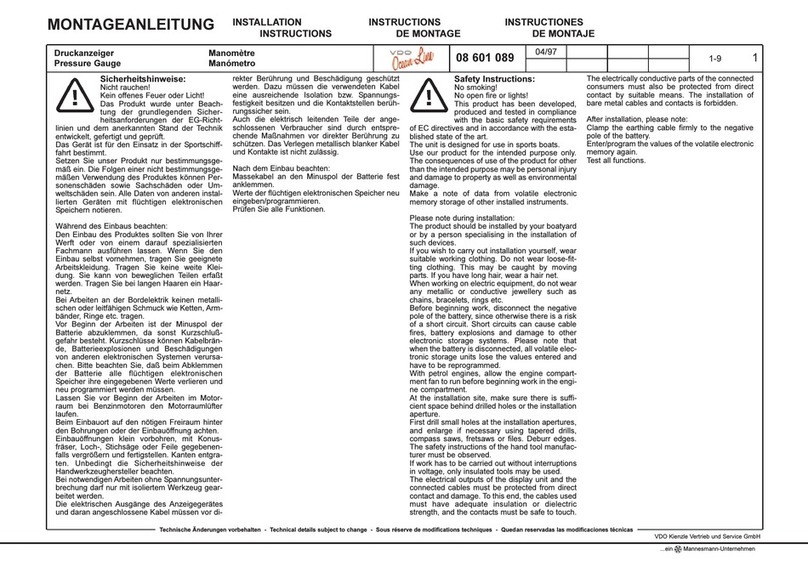
VDO
VDO RESSURE GAUGE installation instructions

Waeco
Waeco MagicWatch MW650 Installation and operating manual
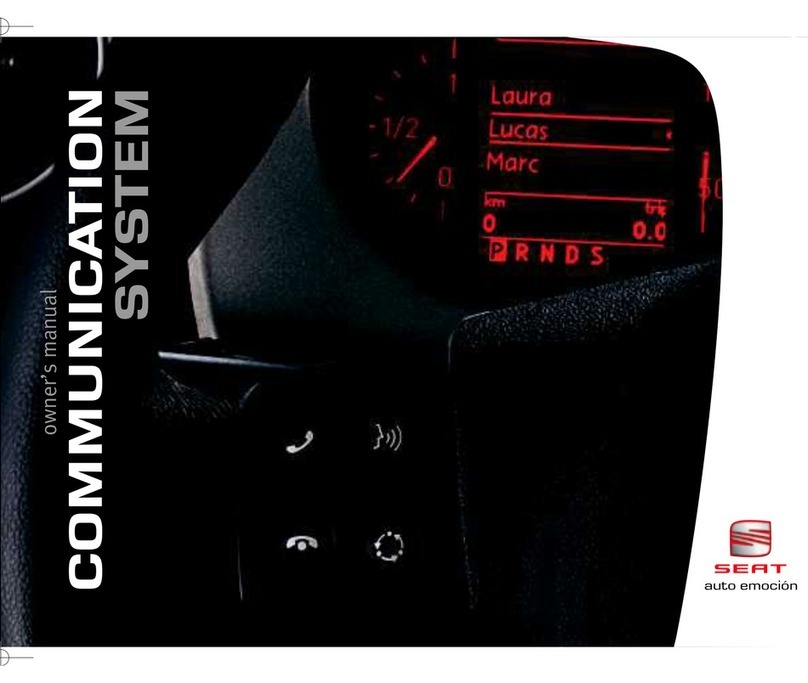
Seat
Seat COMMUNICATION SYSTEM owner's manual

Hectronic
Hectronic Citea Technical Product Manual
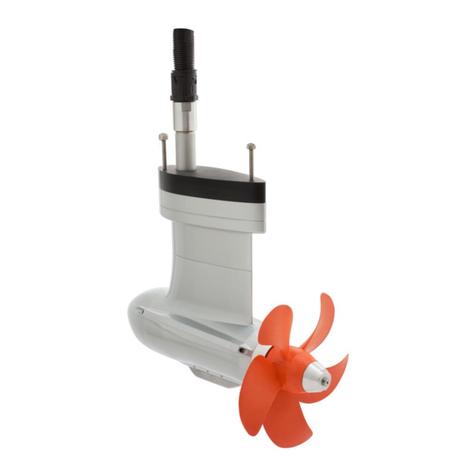
Torqeedo
Torqeedo Cruise 10 FP TorqLink Translation of the original operating instructions

Edge Products
Edge Products Back-up camera installation instructions

Axxess
Axxess AX-DSPX-HYKIA4 installation instructions

LedGlow
LedGlow SMD Slimline Underbody Kit installation guide
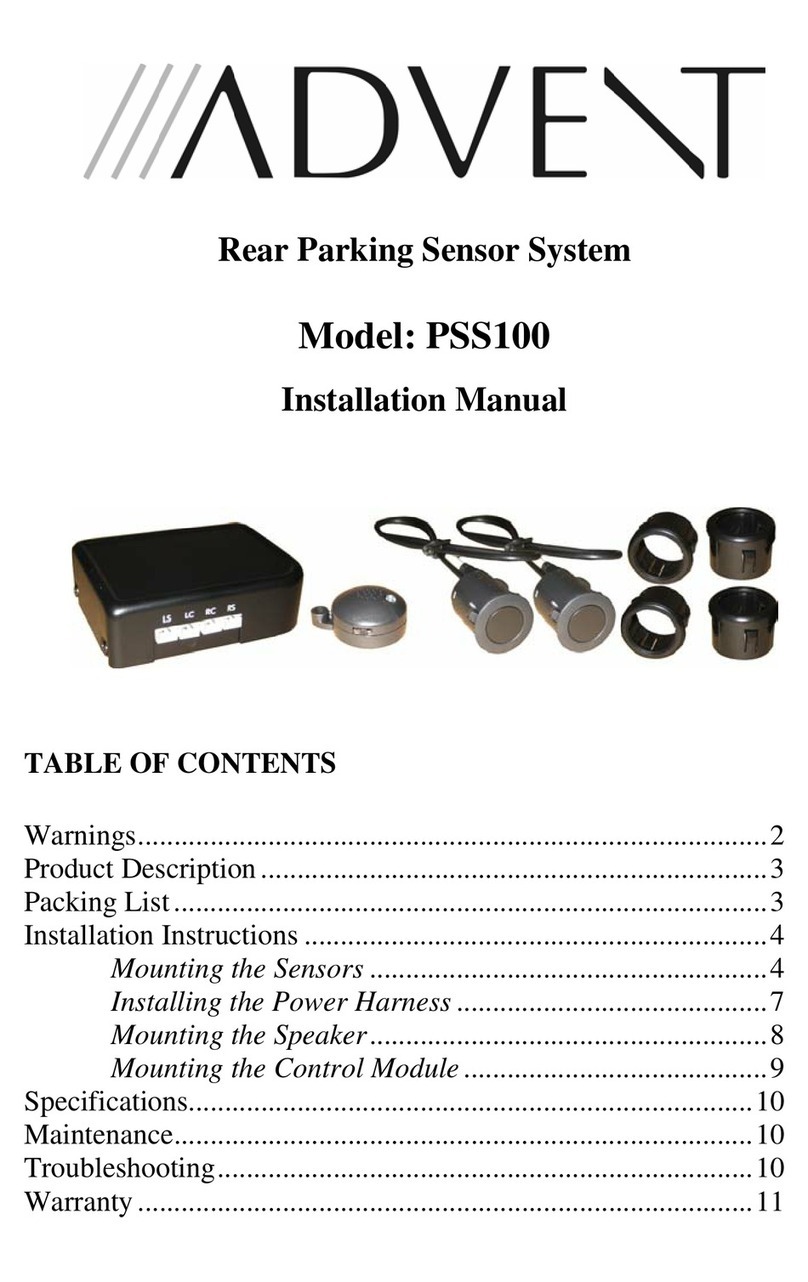
Advent
Advent PSS100 - Standard Rear Only System installation manual

BMW
BMW 66 20 0 007 031 installation instructions
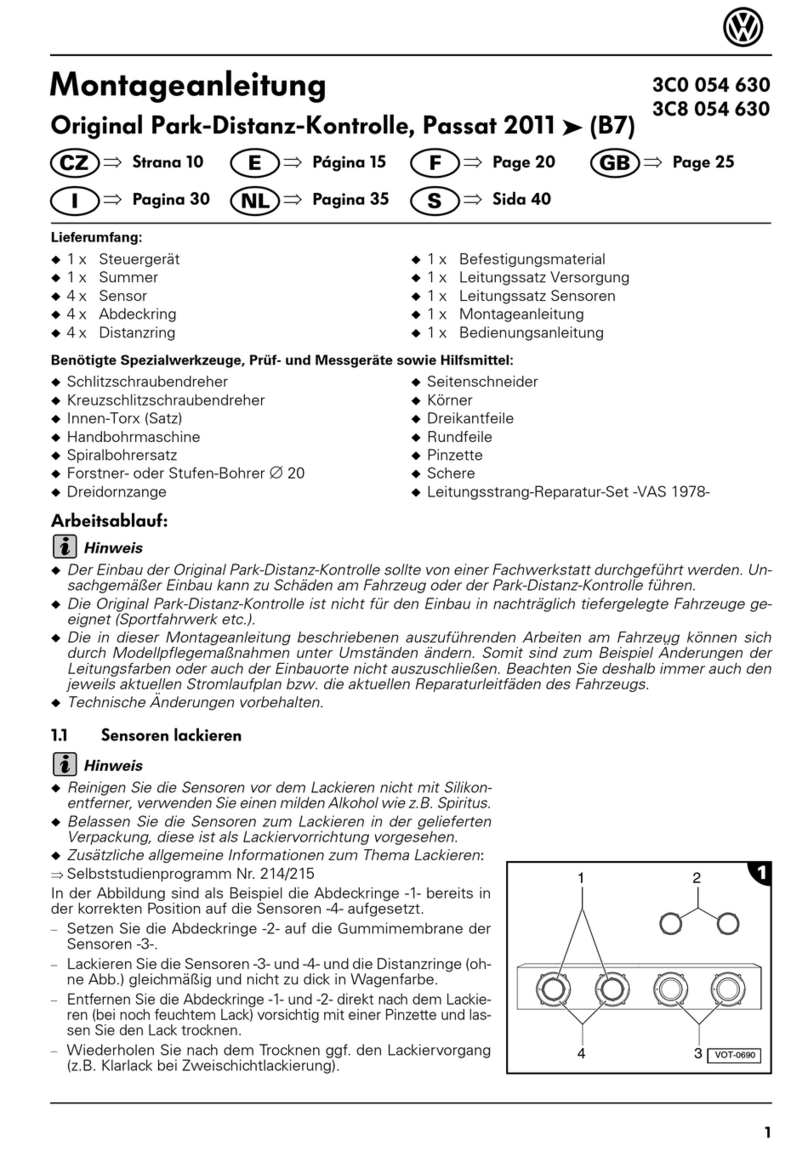
Volkswagen
Volkswagen 3C0 054 630 Assembly instructions




